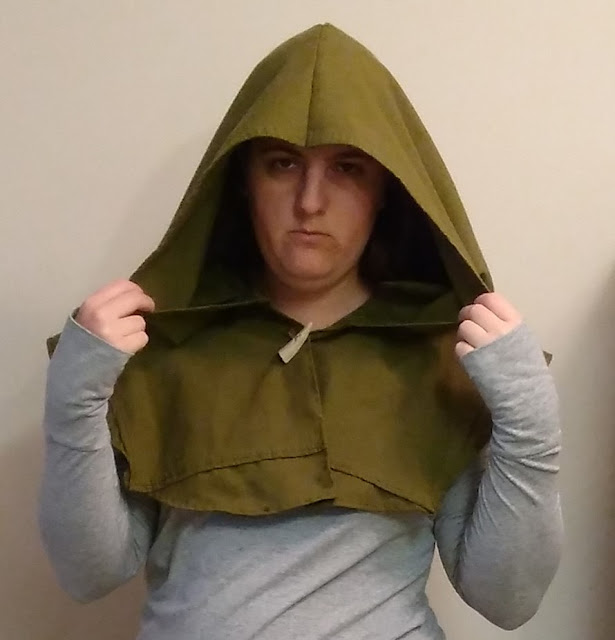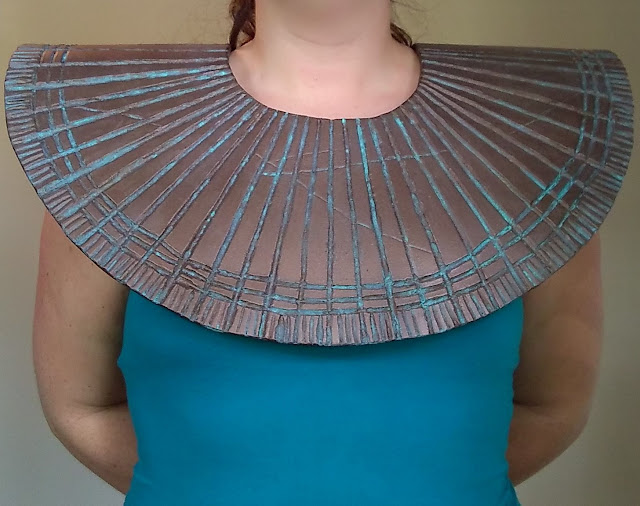How to make the Stargate Anubis Guard Belt
Here is my adventure in creating a belt for the Anubis guard in the original Stargate film. There are lots of small armor pieces necessary to create the Anubis guard, but the belt seems like a good place to start when experimenting with using elastic for straps and belting.
References
Materials
-Foam squares (12mm thick)
-Black nylon webbing (1 inch wide)
-Black elastic (1.5in wide)
References
Materials
-Foam squares (12mm thick)
-Black nylon webbing (1 inch wide)
-Black elastic (1.5in wide)
-Plastidip
-Dark copper metallic spray paint
-Purple decorative glass stones
-Turquoise acrylic paint
-Clear coat sealer
Tools
-Boxcutter
-Dremel tool with sanding drum
1. Gather the materials
The main material needed for this project is 12mm EVA foam. I was able to pick up squares in the form of a playroom foam mats for about $20 from a home improvement store, although I only needed about half of one of these 24in by 24in tiles. You can also pick up Plastidip and a dark copper metallic spray paint from the spray paint section.
From the craft store I purchased a sheet of very thin black foam, not specifically marketed for cosplay work but it will be thin and flexible enough for attaching belt loops to the belt pieces. The decorative glass stones I found on sale in the floral section, and the turquoise paint for the patina details in with the acrylic paints.
2. Make the pattern
To figure out my approach, I did some sketches based on the screenshots and costume photos, and tried to figure out how many pieces were involved. The front-piece seemed to be fused, although possible the buckle is a separate element. Looking at the back, you can see there are at least seven separate pieces, and they seem to be spaced apart and mounted on a wide black belt underneath. I decided the easiest way to accomplish this was to make the buckle a part of the front-piece and then use a knit elastic band to attach the smaller pieces to the front-piece. That way the belt is easy to take on and off. Originally I had planned the belt to clip into position, but found that was not needed.
Then I started drafting the individual elements. This is going to vary based on your own dimensions, but the front-piece should be symmetrical, the belt tapering, and in a V-shape.
Then the smaller pieces should keep the taper and widen. This below shows all the elements cut out of poster board. This is the left side of the belt, from the buckle to the middle of the back.
3. Cut and sand the pieces
Begin tracing the patterns onto the foam. The front-piece with need this pattern traced, and then the strap mirrored on the other side of the buckle to form a V-shaped piece. Also cut out a foam piece that is just the buckle shape. Otherwise, continue to trace and cut out the three tapered pieces, and then again mirrored. If you forget to mirror it the rough side of the foam will be wrong side up for one of the sides. And then cut out one of that last back piece.
I forgot to get a picture of all the separate pieces cut out, but here' a preview of all of them. The extra buckle piece you can see has already been beveled and glued on top of the front-piece.
To shape the buckle, I used the Dremel's cutting wheel and carved into it at a 45 degree angle.
-Dark copper metallic spray paint
-Purple decorative glass stones
-Turquoise acrylic paint
-Clear coat sealer
Tools
-Boxcutter
-Dremel tool with sanding drum
-Superglue
-E6000 craft glue
-Woodburner tool
-Paintbrush
-Foam wedge
-Woodburner tool
-Paintbrush
-Foam wedge
1. Gather the materials
The main material needed for this project is 12mm EVA foam. I was able to pick up squares in the form of a playroom foam mats for about $20 from a home improvement store, although I only needed about half of one of these 24in by 24in tiles. You can also pick up Plastidip and a dark copper metallic spray paint from the spray paint section.
From the craft store I purchased a sheet of very thin black foam, not specifically marketed for cosplay work but it will be thin and flexible enough for attaching belt loops to the belt pieces. The decorative glass stones I found on sale in the floral section, and the turquoise paint for the patina details in with the acrylic paints.
2. Make the pattern
To figure out my approach, I did some sketches based on the screenshots and costume photos, and tried to figure out how many pieces were involved. The front-piece seemed to be fused, although possible the buckle is a separate element. Looking at the back, you can see there are at least seven separate pieces, and they seem to be spaced apart and mounted on a wide black belt underneath. I decided the easiest way to accomplish this was to make the buckle a part of the front-piece and then use a knit elastic band to attach the smaller pieces to the front-piece. That way the belt is easy to take on and off. Originally I had planned the belt to clip into position, but found that was not needed.
Then I started drafting the individual elements. This is going to vary based on your own dimensions, but the front-piece should be symmetrical, the belt tapering, and in a V-shape.
Then the smaller pieces should keep the taper and widen. This below shows all the elements cut out of poster board. This is the left side of the belt, from the buckle to the middle of the back.
3. Cut and sand the pieces
Begin tracing the patterns onto the foam. The front-piece with need this pattern traced, and then the strap mirrored on the other side of the buckle to form a V-shaped piece. Also cut out a foam piece that is just the buckle shape. Otherwise, continue to trace and cut out the three tapered pieces, and then again mirrored. If you forget to mirror it the rough side of the foam will be wrong side up for one of the sides. And then cut out one of that last back piece.
I forgot to get a picture of all the separate pieces cut out, but here' a preview of all of them. The extra buckle piece you can see has already been beveled and glued on top of the front-piece.
To shape the buckle, I used the Dremel's cutting wheel and carved into it at a 45 degree angle.
4. Piece details
First, glue the "buckle" piece into place. It's not an ideal fit but gives the buckle more dimension.
Start sketching out the section lines. This front-piece is a little over 8 inches long on either side of the buckle, and needs to be divided into four 2inch sections. The outer edges have ridges, which you see I've started defining using the woodburner here.
To divide the sections I used a trio of vertical lines, groups of two broad and one narrow. I also added a little more definition to the facets of the buckle by burning the edges.
Here's a close up of the section dividers.
For the three sections furthest from the buckle begin to have jewel and added texture details. I marked the outlines of the glass stones to be placed.
And then started filling in the space around the stone with a sort of "beaten metal" or pebbled texture, made by pressing the woodburner point in. And in the sections next to the buckle, broad vertical lines as is seen in the original.
Continue making the outside ridge lines, beaten metal texture, and negative space left for the jewels and untextured rectangles seen on the individual belt pieces.
And here's what they should look like altogether.
When I re-watched the film I was able to get a closer look at the belt and got a screenshot. To mimic the look of the buckle, I inscribed some more lines as below.
5. Making belt loops and prep
Eventually these pieces will all have to be strung together. To do that, I cut about nine 3inch strips of 1in nylon webbing. I tried this first with a foam sheet, but the result is too stretchy to hold up for long.
Center the strips on the backs of the smaller pieces, and position a strip on either end of the front-piece. Glue into place with E6000 craft glue.
After the face I discovered that the backs of the the pieces can show when worn, and since this foam is brightly colored I decided to go back and spray paint the back of the pieces black. I used some masking tape to protect the straps from the paint.
6. Prime
The next step is to prime the foam for painting. Use a brush to evenly coat Plastidip or Modgepodge across the front-facing surfaces and sides of the pieces.
Tape off the ovals set for where the gems will be on the belt pieces, which should help the glass stones adhere later on.
7. Paint
Next add a few layers of dark copper metallic spray paint. Be sure to allow for drying between coats, and that you're able to cover the sides and texture depressions.
And here's a close up of the painting process.
8. Add patina
To give the belt dimension and age, the next step is to add some patina effects. Although the Horus guards tend to have a different look, the Anubis guard has noticeable green patina that is classic for copper. To achieve this look, all you need is a turquoise acrylic paint, sponge, paper towels, and some water. With the sponge, wipe the paint into the crevices of the piece.
Then with a damp paper towel wipe off the excess, so that only traces of paint are left in the depressions and grooves. This mimics the action of exposed copper, which oxidizes and accumulates patina most often in areas of an object that trap moisture.
Finish off with a couple layers of clear coat sealer to protect the paint.
9. Add gems
Once dry, remove the tape. Using the E6000 glue, start adding the decorative glass stones to the spaces left for them.
Let sit for several hours to ensure that the glue dries properly.
10. Make the belt
The belt is going to be a different length depending on your size, but to get an estimate on how much you need hold the front-piece in place and measure the length needed to go around the back, and then add about 6 more inches to account for attaching the belt. For me this was about 31 inches, though if in doubt make the belt longer rather than shorter. Cut the desired length of the black knit elastic. Then loop one end around one of the front-piece's straps, and use a couple of rows of running stitches to attach.
Then feed the elastic through the other pieces, being careful of their order.
Put on the belt, and then safety pin the elastic into place on the other side of the front-piece. Be sure that this doesn't stretch the elastic much, you want the fit to be firm but not restrictive. Then sew the other loop around the other front-piece strap.
And there you have it, a belt that is very close to screen-accurate, and is relatively simple to create. Good luck and keep crafting!
Addendum... after I made this I did find a better reference image of the belt. So not terribly screen-accurate but still pretty good.










































Comments
Post a Comment